Impact of ICME- and SIR/CIR-Driven Geomagnetic Storms on the Ionosphere over Hungary
Abstract
1. Introduction
2. Data and Methods
2.1. Data
- SC (Sudden Commencement) times and the international quiet days (Q-days) from the Kp index are derived by GFZ Potsdam, Germany, and by ISGI (International Service of Geomagnetic Indices), Spain.
- ICME source dates and ICME comments were used from different NASA websites.
- ACE/WIND shock dates were provided by three different websites. In addition, we used the list of our co-authors, called Dalya & Opitz ACE ICME start and end dates (available on [60]).
- CIR and solar wind high-speed stream (HSS) catalogs were also used for the creation of our list.
- Solar and geomagnetic indices: The Dst-, AE- index, and Dstmin times were used with a 1-h resolution from OMNIWeb.
- Ionosonde data: the ionospheric foF2 parameter data was taken from the ionosonde station of Nagycenk Geophysical Observatory, Hungary (IAGA code: NCK) [61]. Its McIllwain number is L = 1.9, geomagnetic latitude: 46.17°, geomagnetic longitude: 98.85°, and inclination (dip angle): 66.83°, therefore, this station is at a sub-auroral (midlatitude) site in the Northern Hemisphere. The parameters from the ionograms were evaluated manually. At the examined location, a Polish VISRC-2 type of ionosonde monitored the ionosphere between 2007 and 2018 [61,62,63]. The frequency range of the instrument was set to 1 MHz–16 MHz, and this range was divided into 1000 different frequencies during sounding. The instrument sampled the ionosphere every half hour. The transmitter power was 500 W. With the manual ionogram processing software (called ipp_ox, developed by the Space Research Center of the Polish Academy of Sciences), the accuracy of the parameter readings is 1 km for altitude values and 0.05 MHz for frequencies (no automatically evaluated data are available).
2.2. Methods
- The first (1st) method: Daytime changes of ICME and SIR/CIR events
- 2.
- The second (2nd) method: Changes according to the local time of Dstmin
- -
- Post-midnight: after midnight and before sunrise
- -
- Daytime: after sunrise and before sunset
- -
- Pre-midnight: after sunset and before midnight
- 3.
- The third (3rd) method: 3D plotting of geomagnetic indices versus time versus deltafoF2
3. Results
3.1. 1st Method: Daytime Changes of ICME and SIR/CIR Events
3.1.1. Winter Events

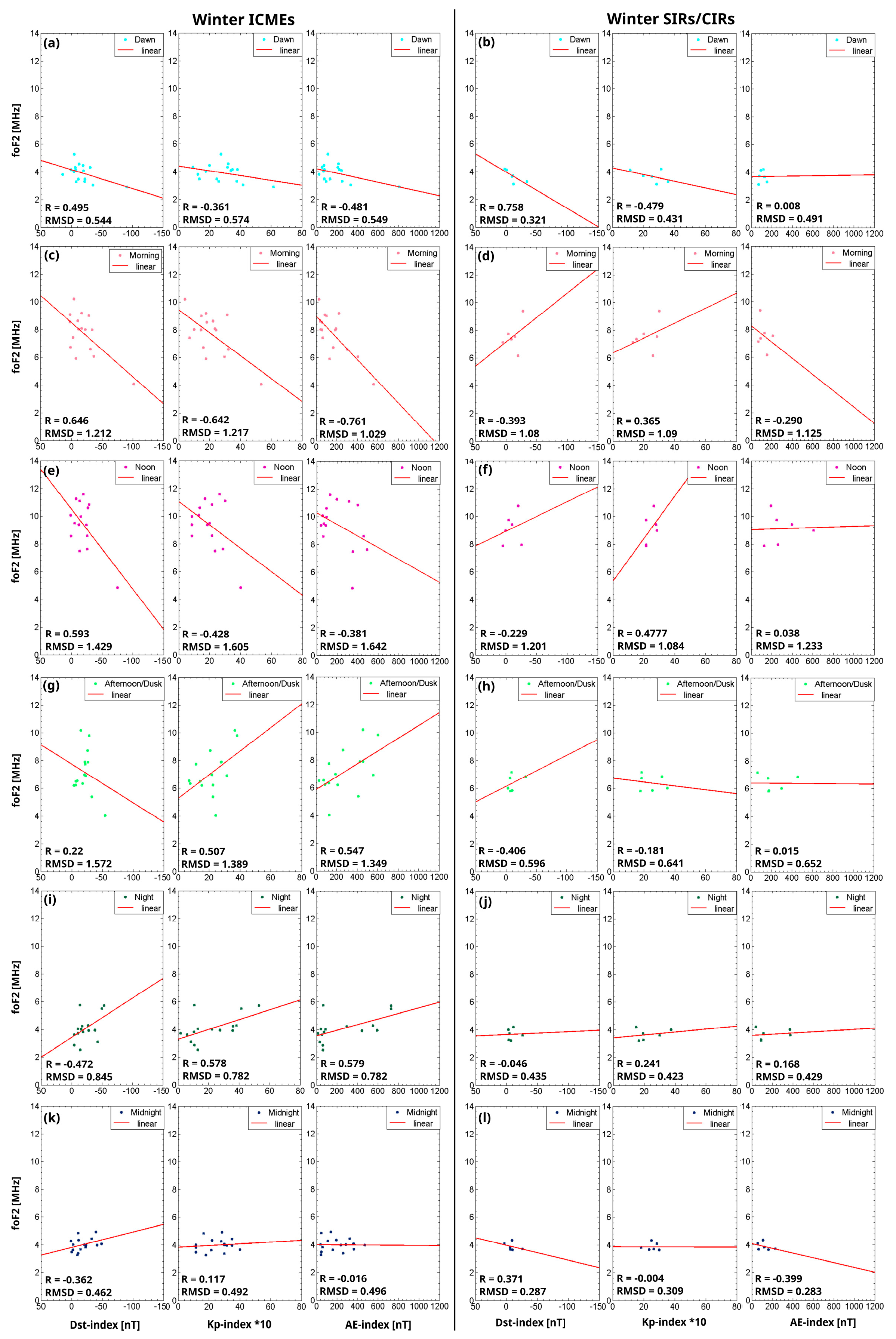
3.1.2. Summer Events

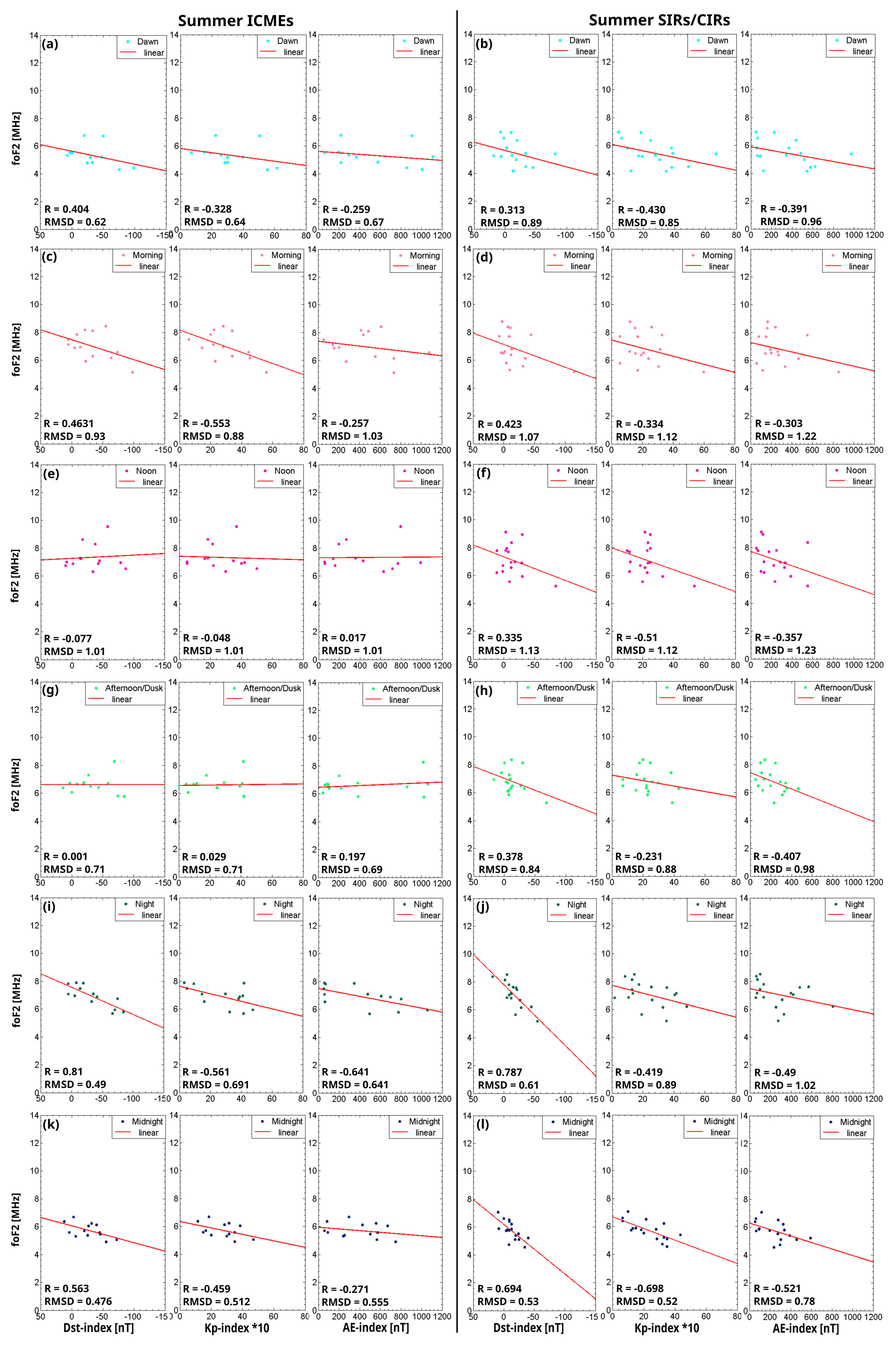
3.1.3. Equinox Events
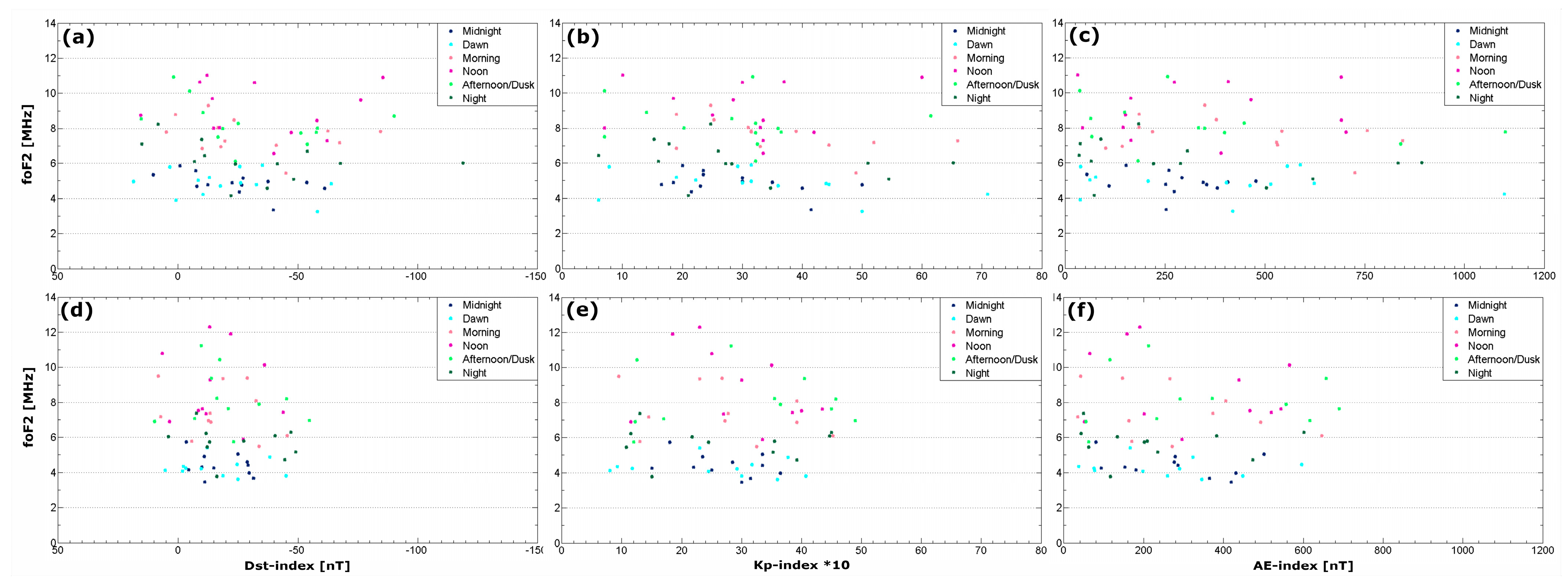
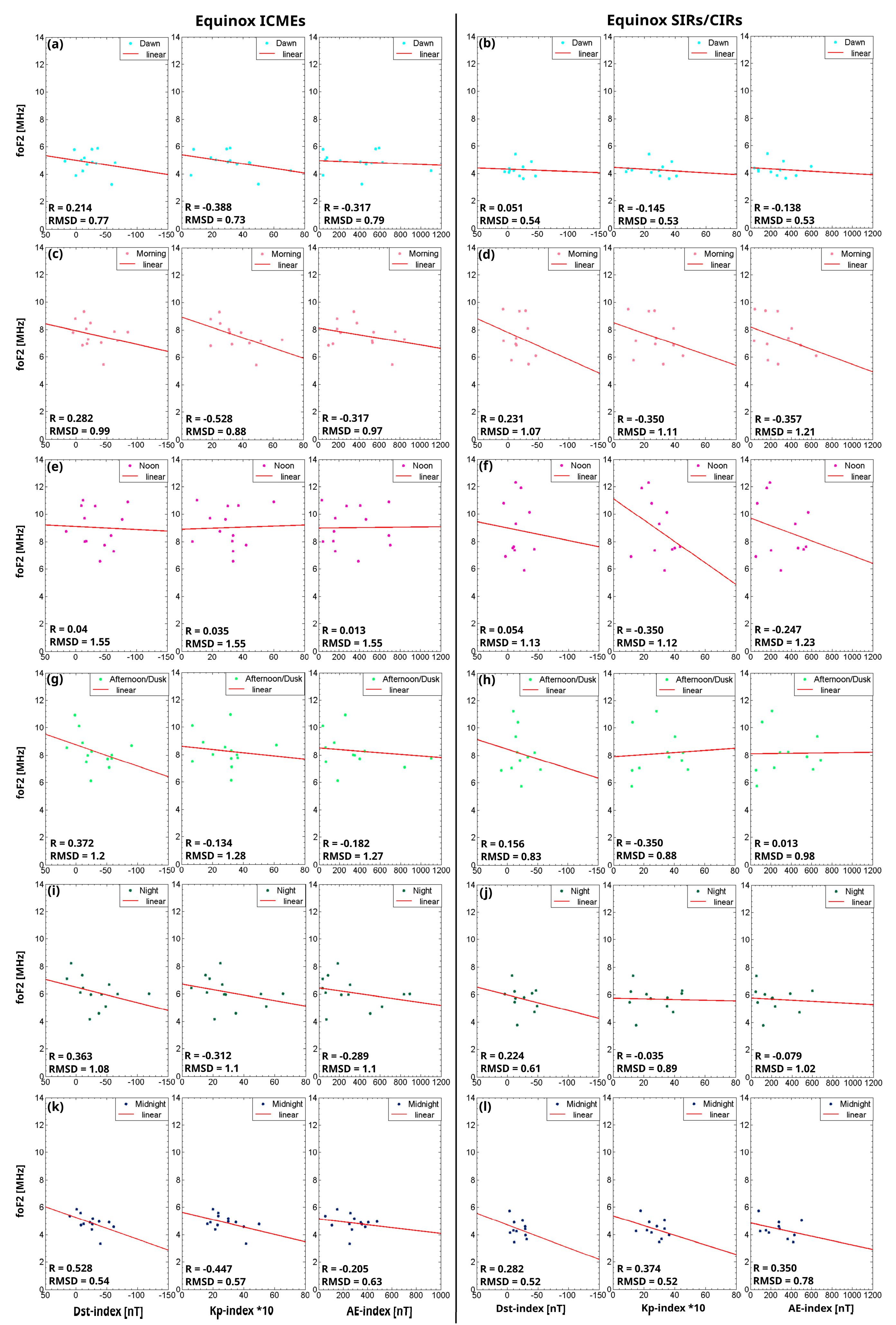
3.2. Second Method: Changes According to the Local Time of the Dstmin
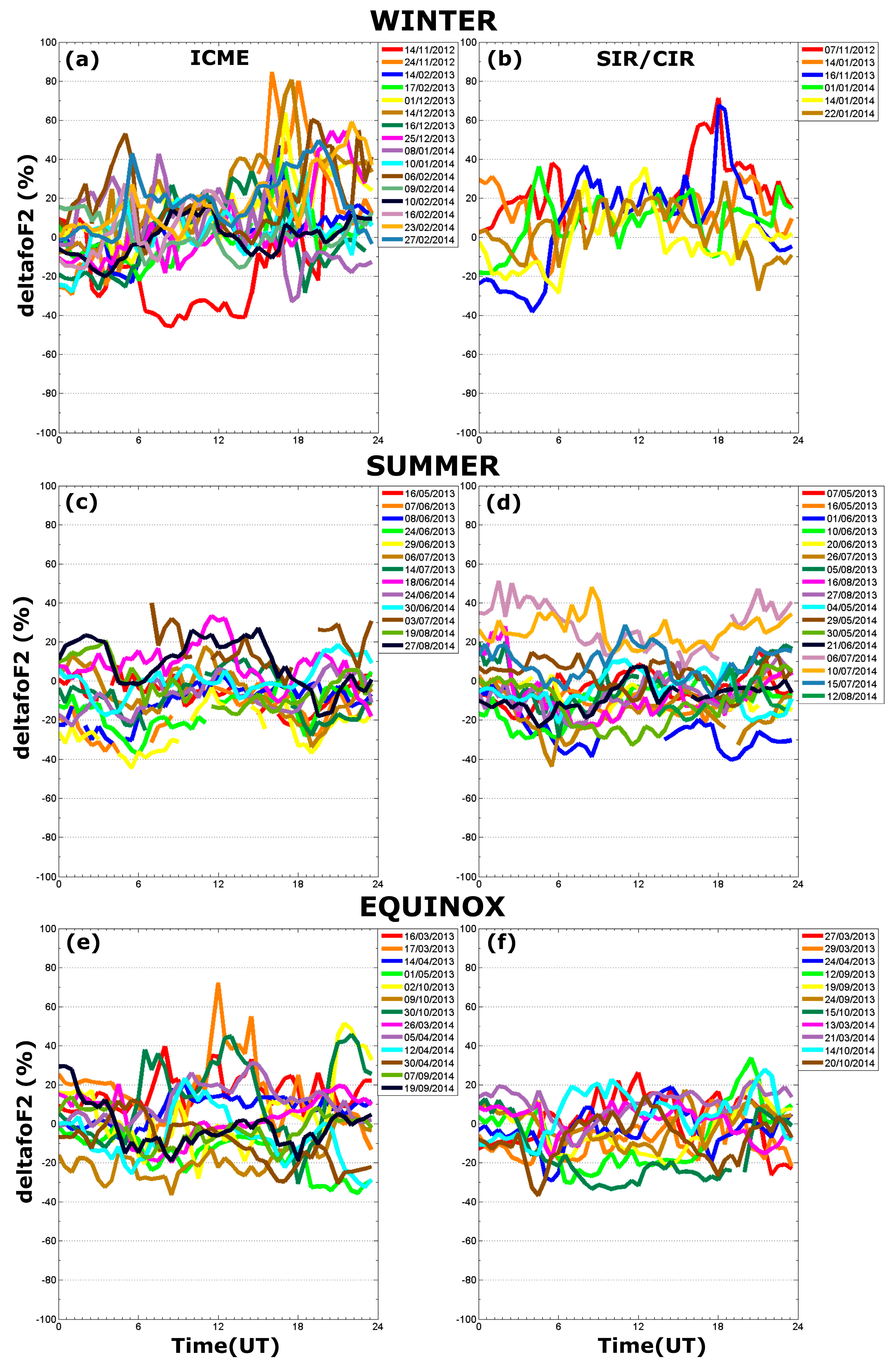
- (1)
- ICME can cause larger disturbances in the F2-layer electron density both in the negative and positive directions, while the impact caused by the SIR/CIR-driven storms is more moderate (especially during winter and equinox).
- (2)
- The effect in the second case (SIR/CIR-driven storm) has clearer seasonal dependence: one can see a positive phase in the winter, while a mainly negative phase occurs in summer during the day.
- (3)
- In winter, we can see the dusk effect (increased values after sunset) in both cases.
3.3. Third Method: 3D Plotting of Geomagnetic Indices Versus Time Versus deltafoF2
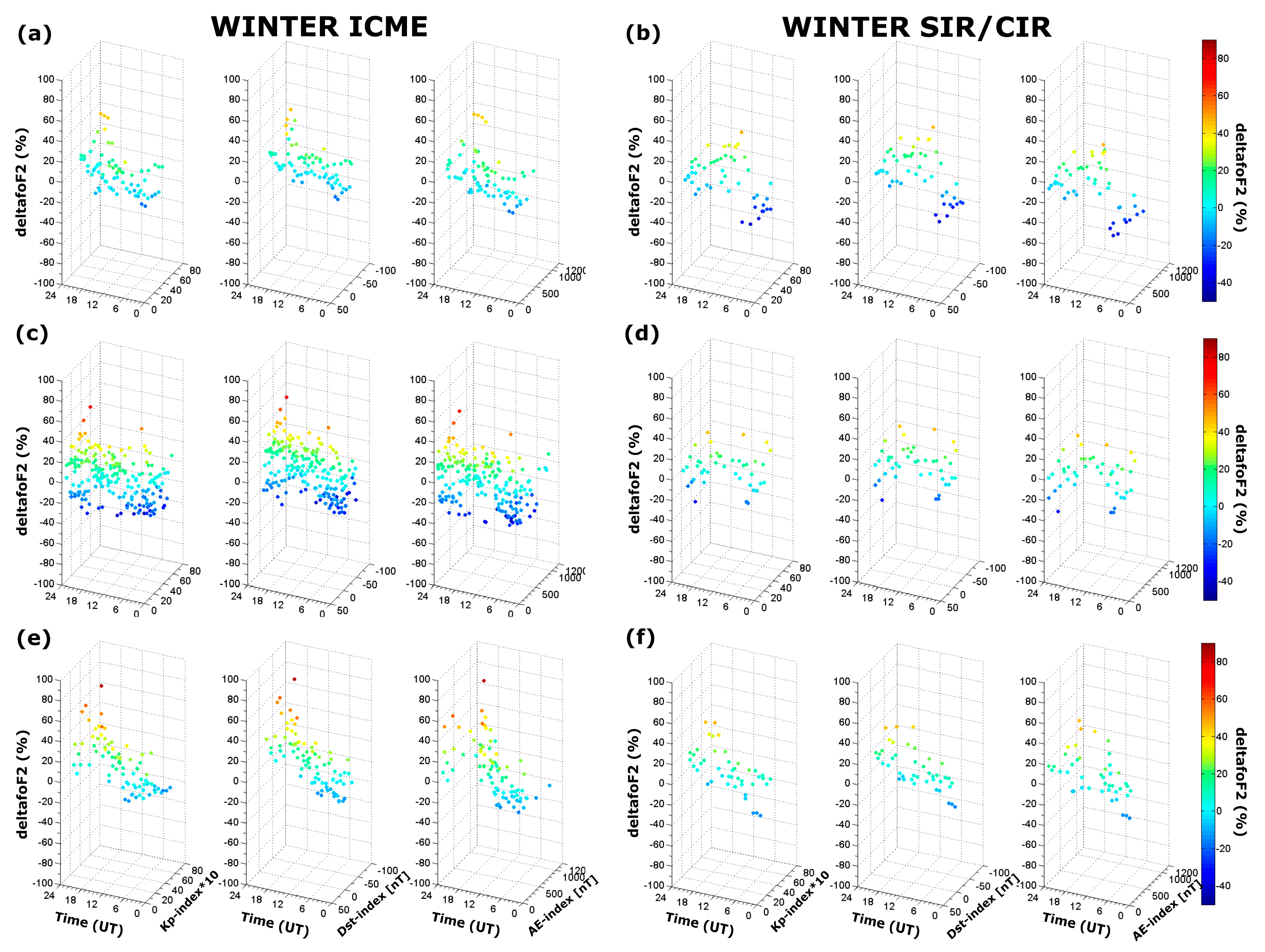


4. Discussion and Concluding Remarks
- During the investigation of the different phase of the day groups using 4-h average foF2 data (first method based on [23]), our main conclusion is, that winter ICME-driven events show a decreasing trend as a function of increasing geomagnetic indices at Dawn, Morning and Noon group. On the contrary, an increasing trend is observed in Afternoon/Dusk and Night groups by ICME-driven events. For SIR/CIR-driven events, we cannot determine an obvious trend as a result of the few amount of events.
- In summer, a decrease in foF2 as a function of increasing geomagnetic activity is observed in most cases for both ICME- and SIR/CIR-driven events.
- Equinox events behave similarly to the summer ones, the difference is that the data points are more scattered, therefore the fitting is less reliable.
- Based on our results of the first analysis method, it is strengthened that more than six events are needed if we want to determine any trend in the foF2 parameter as a function of any geomagnetic index.
- The most significant correlations were between the Dst index and the foF2 parameter for the summer Night groups. The linear fitting is the most reliable based on the RMSD between the Dst and foF2 with RMSD = 0.258 for the winter SIR/CIR Midnight group.
- The trends of the linear fitting are fairly consistent with the literature on the behavior of the electron density in the F2 layer as a function of time during different seasons and phases of the day.
- The second method, ICME, can cause a larger disturbance in the F2 layer electron density both in the negative and positive directions, while the impact caused by the SIR/CIR-driven storms is more moderate and predictable.
- Representation of the data by the third method (3D plots), gives a better picture of the changes in electron density as a function of increasing geomagnetic activity and time.
- We conclude that ICME-induced events cause electron density changes over a wider range, while SIR/CIR-induced perturbations are more predictable.
- Another important conclusion is that if one would like to compare the ionospheric effects of the ICME and SIR/CIR-driven geomagnetic storms, the time of the Dstmin can be used instead of the time of the SSC since generally there is no SSC for the SIR/CIR-driven storms. Nevertheless, the time of the Dstmin should always be taken into account, as different ionospheric responses can be expected depending on the time of day when the Dstmin occurred, thus when the ring current was the strongest.
- Our analysis strengthens the main seasonal dependence of the ionospheric response found by previous studies that the positive phase is more probable in winter, while the negative phase occurs mainly in summer in the Northern Hemisphere.
- We have also found by our analysis (second and third methods) some of the typical diurnal patterns of the foF2 during geomagnetic storms (previously described in the literature), such as the twin peaks with the midday bite or the “dusk effect” after sunset.
- In future studies, it will be important to investigate these events using other analysis methods, like, e.g., superposed epoch analysis, where we plan and suggest using local times of Dstmin as the null time and longer time interval (36 h instead of 24). Furthermore, we find it important to use cross-correlation analysis on these data to disclose the time-shifted ionospheric changes caused by the geomagnetic storms. In addition, using more Digisonde station data (from Europe and the opposite hemisphere) and other local and regional geomagnetic/ionospheric indices is also an important aim in the next research project.
Supplementary Materials
Author Contributions
Funding
Institutional Review Board Statement
Informed Consent Statement
Data Availability Statement
Acknowledgments
Conflicts of Interest
References
- Mendillo, M.; Narvaez, C. Ionospheric storms at geophysically-equivalent sites—Part 2: Local time storm patterns for sub-auroral ionospheres. Ann. Geophys. 2010, 28, 1449–1462. [Google Scholar] [CrossRef]
- Gonzalez, W.D.; Joselyn, J.A.; Kamide, Y.; Kroehl, H.W.; Rostoker, G.; Tsurutani, B.T.; Vasyliunas, V.M. What is a geomagnetic storm? J. Geophys. Res. Space Phys. 1994, 99, 5771–5792. [Google Scholar] [CrossRef]
- Tsurutani, B.T.; Gonzalez, W.D.; Gonzalez, A.L.C.; Guarnieri, F.L.; Gopalswamy, N.; Grande, M.; Kamide, Y.; Kasahara, Y.; Lu, G.; Mann, I.; et al. Corotating solar wind streams and recurrent geomagnetic activity: A review. J. Geophys. Res. Atmos. 2006, 111, A07S01. [Google Scholar] [CrossRef]
- Denton, M.H.; Ulich, T.; Turunen, E. Modification of midlatitude ionospheric parameters in the F2 layer by persistent high-speed solar wind streams. Space Weather 2009, 7, 1–10. [Google Scholar] [CrossRef]
- Chen, G.-M.; Xu, J.; Wang, W.; Burns, A.G. A comparison of the effects of CIR- and CME-induced geomagnetic activity on thermospheric densities and spacecraft orbits: Statistical studies. J. Geophys. Res. Space Phys. 2014, 119, 7928–7939. [Google Scholar] [CrossRef]
- Chen, G.-M.; Xu, J.; Wang, W.; Lei, J.; Burns, A.G. A comparison of the effects of CIR- and CME-induced geomagnetic activity on thermospheric densities and spacecraft orbits: Case studies. J. Geophys. Res. Atmos. 2012, 117, 8315. [Google Scholar] [CrossRef]
- Shen, X.; Hudson, M.K.; Jaynes, A.N.; Shi, Q.; Tian, A.; Claudepierre, S.G.; Qin, M.; Zong, Q.; Sun, W. Statistical study of the storm time radiation belt evolution during Van Allen Probes era: CME- versus CIR-driven storms. J. Geophys. Res. Space Phys. 2017, 122, 8327–8339. [Google Scholar] [CrossRef]
- Crooker, N.U.; Cliver, E.W. Postmodern view of M-regions. J. Geophys. Res. Atmos. 1994, 99, 23383–23390. [Google Scholar] [CrossRef]
- Burns, A.G.; Solomon, S.C.; Wang, W.; Qian, L.; Zhang, Y.; Paxton, L.J. Daytime climatology of ionospheric NmF2 and hmF2 from COSMIC data. J. Geophys. Res. Atmos. 2012, 117, 9315. [Google Scholar] [CrossRef]
- Kamide, Y. Interplanetary and magnetospheric electric fields during geomagnetic storms: What is more important, steady-state fields or fluctuating fields? J. Atmos. Sol. Terr. Phys. 2001, 63, 413–420. [Google Scholar] [CrossRef]
- Buresova, D.; Lastovicka, J.; Hejda, P.; Bochnicek, J. Ionospheric disturbances under low solar activity conditions. Adv. Space Res. 2014, 54, 185–196. [Google Scholar] [CrossRef]
- Denton, M.H.; Borovsky, J.E.; Skoug, R.M.; Thomsen, M.F.; Lavraud, B.; Henderson, M.G.; McPherron, R.L.; Zhang, J.C.; Liemohn, M.W. Geomagnetic storms driven by ICME- and CIR-dominated solar wind. J. Geophys. Res. Atmos. 2006, 111, 7. [Google Scholar] [CrossRef]
- Allen, R.C.; Ho, G.C.; Jian, L.K.; Mason, G.M.; Vines, S.K.; Lario, D. Predictive Capabilities and Limitations of Stream Interaction Region Observations at Different Solar Longitudes. Space Weather 2020, 18, e2019SW002437. [Google Scholar] [CrossRef]
- Tsurutani, B.T.; Gonzalez, W.D.; Kamide, Y. Magnetic Storms. Surv. Geophys. 1997, 18, 363–383. [Google Scholar] [CrossRef]
- Richardson, I.G. Solar wind stream interaction regions throughout the heliosphere. Living Rev. Sol. Phys. 2018, 15, 1–95. [Google Scholar] [CrossRef]
- Chi, Y.; Shen, C.; Luo, B.; Wang, Y.; Xu, M. Geoeffectiveness of Stream Interaction Regions From 1995 to 2016. Space Weather 2018, 16, 1960–1971. [Google Scholar] [CrossRef]
- McGranaghan, R.; Knipp, D.J.; McPherron, R.L.; Hunt, L.A. Impact of equinoctial high-speed stream structures on thermospheric responses. Space Weather 2014, 12, 277–297. [Google Scholar] [CrossRef]
- Tsurutani, B.T.; Smith, E.J.; Pyle, K.R.; Simpson, J.A. Energetic protons accelerated at corotating shocks: Pioneer 10 and 11 observations from 1 to 6 AU. J. Geophys. Res. Atmos. 1982, 87, 7389–7404. [Google Scholar] [CrossRef]
- Zheng, Y.; Fok, M.-C.; Khazanov, G.V. A radiation belt-ring current forecasting model. Space Weather 2003, 1, 1013. [Google Scholar] [CrossRef]
- Turner, N.E.; Cramer, W.D.; Earles, S.K.; Emery, B.A. Geoefficiency and energy partitioning in CIR-driven and CME-driven storms. J. Atmos. Sol. Terr. Phys. 2009, 71, 1023–1031. [Google Scholar] [CrossRef]
- Emery, B.A.; Richardson, I.G.; Evans, D.S.; Rich, F.J. Solar wind structure sources and periodicities of auroral electron power over three solar cycles. J. Atmos. Sol. Terr. Phys. 2009, 71, 1157–1175. [Google Scholar] [CrossRef]
- Bingham, S.T.W.R. The Storm Time Response of the Inner Magnetosphere during Coronal Mass Ejection and Corotating Interaction Region Driven Storms. Ph.D. Thesis, University of New Hampshire, Durham, NH, USA, 2019. [Google Scholar]
- Mendillo, M.; Narvaez, C. Ionospheric storms at geophysically-equivalent sites—Part 1: Storm-time patterns for sub-auroral ionospheres. Ann. Geophys. 2009, 27, 1679–1694. [Google Scholar] [CrossRef]
- Gopalswamy, N. Solar connections of geoeffective magnetic structures. J. Atmos. Sol. Terr. Phys. 2008, 70, 2078–2100. [Google Scholar] [CrossRef]
- Kane, T.A.; Makarevich, R.A. HF radar observations of the F region ionospheric plasma response to Storm Sudden Commencements. J. Geophys. Res. Atmos. 2010, 115, 1–13. [Google Scholar] [CrossRef]
- Matzka, J.; Stolle, C.; Yamazaki, Y.; Bronkalla, O.; Morschhauser, A. The Geomagnetic Kp Index and Derived Indices of Geomagnetic Activity. Space Weather 2021, 19, e2020SW002641. [Google Scholar] [CrossRef]
- Campbell, W.H. Geomagnetic storms, the Dst ring-current myth and lognormal distributions. J. Atmos. Terr. Phys. 1996, 58, 1171–1187. [Google Scholar] [CrossRef]
- Daglis, I.A. Ring Current Dynamics. Space Sci. Rev. 2006, 124, 183–202. [Google Scholar] [CrossRef]
- Danilov, A. Ionospheric F-region response to geomagnetic disturbances. Adv. Space Res. 2013, 52, 343–366. [Google Scholar] [CrossRef]
- Burton, R.K.; McPherron, R.L.; Russell, C.T. An empirical relationship between interplanetary conditions and Dst. J. Geophys. Res. Atmos. 1975, 80, 4204–4214. [Google Scholar] [CrossRef]
- Kalegaev, V.V.; Makarenkov, E.V. Dynamics of magnetospheric current systems during magnetic storms of different intensity. Geomagn. Aeron. 2006, 46, 570–579. [Google Scholar] [CrossRef]
- Rishbeth, H.; Field, P. Latitude and solar-cycle patterns in the response of the ionosphere F2-layer to geomagnetic activity. Adv. Space Res. 1997, 20, 1689–1692. [Google Scholar] [CrossRef]
- Prölss, G.W. Physics of the Earth’s Space Environment: An Introduction; Springer: Berlin/Heidelberg, Germany, 2004. [Google Scholar] [CrossRef]
- Buonsanto, M. Ionospheric Storms—A Review. Space Sci. Rev. 1999, 88, 563–601. [Google Scholar] [CrossRef]
- Mendillo, M. Storms in the ionosphere: Patterns and processes for total electron content. Rev. Geophys. 2006, 44, 1–47. [Google Scholar] [CrossRef]
- Kumar, E.A.; Kumar, S. Geomagnetic Storm Effect on F2-Region Ionosphere during 2012 at Low- and Mid-Latitude-Latitude Stations in the Southern Hemisphere. Atmosphere 2022, 13, 480. [Google Scholar] [CrossRef]
- Burešová, D.; Laštovička, J. Pre-storm enhancements of foF2 above Europe. Adv. Space Res. 2007, 39, 1298–1303. [Google Scholar] [CrossRef]
- Danilov, A.D.; Lastovicka, J. Effects of geomagnetic storms on the ionosphere and atmosphere. Int. J. Geomagn. Aeron. 2001, 2, 209–224. [Google Scholar]
- Zhai, C.; Tang, S.; Peng, W.; Cheng, X.; Zheng, D. Driver of the Positive Ionospheric Storm over the South American Sector during 4 November 2021 Geomagnetic Storm. Remote Sens. 2023, 15, 111. [Google Scholar] [CrossRef]
- Bojilova, R.; Mukhtarov, P. Response of the electron density profiles to geomagnetic disturbances in January 2005. Stud. Geophys. Geod. 2019, 63, 436–454. [Google Scholar] [CrossRef]
- Berényi, K.A.; Heilig, B.; Urbář, J.; Kouba, D.; Kis, Á.; Barta, V. Comprehensive analysis of the ionospheric response to the largest geomagnetic storms from solar cycle 24 over Europe. Front. Astron. Space Sci. 2023, 10, 1092850. [Google Scholar] [CrossRef]
- Immel, T.J.; Mannucci, A.J. Ionospheric redistribution during geomagnetic storms. J. Geophys. Res. Space Phys. 2013, 118, 7928–7939. [Google Scholar] [CrossRef]
- Du, Z.L. The correlation between solar and geomagnetic activity—Part 1: Two-term decomposition of geomagnetic activity. Ann. Geophys. 2011, 29, 1331–1340. [Google Scholar] [CrossRef][Green Version]
- Du, Z.L. The correlation between solar and geomagnetic activity—Part 2: Long-term trends. Ann. Geophys. 2011, 29, 1341–1348. [Google Scholar] [CrossRef]
- Brown, S.; Bilitza, D.; Yiğit, E. Ionosonde-based indices for improved representation of solar cycle variation in the International Reference Ionosphere model. J. Atmos. Sol. Terr. Phys. 2018, 171, 137–146. [Google Scholar] [CrossRef]
- Gulyaeva, T.L.; Haralambous, H. Three-hourly Indices of Ionospheric Activity. Geomagn. Aeron. 2021, 61, 836–845. [Google Scholar] [CrossRef]
- Gulyaeva, T.; Haralambous, H.; Stanislawska, I. Persistent perturbations of ionosphere at diminution of solar and geomagnetic activity during 21–24 solar cycles. J. Atmos. Sol. Terr. Phys. 2021, 221, 105706. [Google Scholar] [CrossRef]
- Pietrella, M.; Perrone, L. A local ionospheric model for forecasting the critical frequency of the F2 layer during disturbed geomagnetic and ionospheric conditions. Ann. Geophys. 2008, 26, 323–334. [Google Scholar] [CrossRef][Green Version]
- Perrone, L.; Mikhailov, A.V. SRF2—A Short-Term (1–24)hfoF2 Prediction Method. Space Weather 2022, 20, e2022SW003047. [Google Scholar] [CrossRef]
- Boroyev, R.N.; Vasiliev, M.S.; Baishev, D.G. The relationship between geomagnetic indices and the interplanetary medium parameters in magnetic storm main phases during CIR and ICME events. J. Atmos. Sol. Terr. Phys. 2020, 204, 105290. [Google Scholar] [CrossRef]
- Mikhailov, A.V.; Perrone, L. Geomagnetic control of the midlatitude daytime fo F 1 and fo F 2 long-term variations: Physical interpretation using European observations. J. Geophys. Res. Space Phys. 2016, 121, 7193–7203. [Google Scholar] [CrossRef]
- Tshisaphungo, M.; Habarulema, J.B.; McKinnell, L.-A. Modeling ionospheric foF2 response during geomagnetic storms using neural network and linear regression techniques. Adv. Space Res. 2018, 61, 2891–2903. [Google Scholar] [CrossRef]
- Zolesi, B.; Cander, L.R.; De Franceschi, G. Simplified ionospheric regional model for telecommunication applications. Radio Sci. 1993, 28, 603–612. [Google Scholar] [CrossRef]
- Zolesi, B.; Cander, L.R.; De Franceschi, G. On the potential applicability of the simplified ionospheric regional model to different midlatitude areas. Radio Sci. 1996, 31, 547–552. [Google Scholar] [CrossRef]
- Liu, L.; Wan, W.; Ning, B. Statistical modeling of ionospheric foF2 over Wuhan. Radio Sci. 2004, 39, 1–10. [Google Scholar] [CrossRef]
- Laštovička, J.; Mikhailov, A.; Ulich, T.; Bremer, J.; Elias, A.; de Adler, N.O.; Jara, V.; del Rio, R.A.; Foppiano, A.; Ovalle, E.; et al. Long-term trends in foF2: A comparison of various methods. J. Atmos. Sol. Terr. Phys. 2006, 68, 1854–1870. [Google Scholar] [CrossRef]
- Yue, X.; Wan, W.; Liu, L.; Ning, B.; Zhao, B. Applying artificial neural network to derive long-term foF2 trends in the Asia/Pacific sector from ionosonde observations. J. Geophys. Res. Atmos. 2006, 111, 10303. [Google Scholar] [CrossRef]
- Schmölter, E.; Berdermann, J. Predicting the Effects of Solar Storms on the Ionosphere Based on a Comparison of Real-Time Solar Wind Data with the Best-Fitting Historical Storm Event. Atmosphere 2021, 12, 1684. [Google Scholar] [CrossRef]
- Berényi, K. Unique List of Clear ICME- and SIR/CIR-Related Geomagnetic Storm Events from the Maximum of 24 Solar Cycle (Nov 2012–Oct 2014). 2023. Volume 1. Available online: https://data.mendeley.com/datasets/n245scjzk4/1 (accessed on 12 June 2023).
- Dalya, Z.; Opitz, A.; Biro, N. Duration of ICME Signatures in In-Situ Data from Several Space Probes for the Time Interval of 2004–2021. 2023. Volume 1. Available online: https://data.mendeley.com/datasets/4zwbp8k7cr/1 (accessed on 9 June 2023).
- Bór, J.; Sátori, G.; Barta, V.; Szabóné-André, K.; Szendrői, J.; Wesztergom, V.; Bozóki, T.; Buzás, A.; Koronczay, D. Measurements of atmospheric electricity in the Széchenyi István Geophysical Observatory, Hungary. Hist. Geo Space Sci. 2020, 11, 53–70. [Google Scholar] [CrossRef]
- Berényi, K.; Barta, V.; Kis, Á. Midlatitude ionospheric F2-layer response to eruptive solar events-caused geomagnetic disturbances over Hungary during the maximum of the solar cycle 24: A case study. Adv. Space Res. 2018, 61, 1230–1243. [Google Scholar] [CrossRef]
- Barta, V.; Natras, R.; Srećković, V.; Koronczay, D.; Schmidt, M.; Šulic, D. Multi-instrumental investigation of the solar flares impact on the ionosphere on 05–06 December 2006. Front. Environ. Sci. 2022, 10, 1174. [Google Scholar] [CrossRef]
- Rishbeth, H.; Mendillo, M. Patterns of F2-layer variability. J. Atmos. Sol. Terr. Phys. 2001, 63, 1661–1680. [Google Scholar] [CrossRef]
- Zou, L.; Rishbeth, H.; Müller-Wodarg, I.C.F.; Aylward, A.D.; Millward, G.H.; Fuller-Rowell, T.J.; Idenden, D.W.; Moffett, R.J. Annual and semiannual variations in the ionospheric F2-layer. I. Modelling. Ann. Geophys. 2000, 18, 927–944. [Google Scholar] [CrossRef]
- Zhang, D.H.; Xiao, Z.; Hao, Y.-Q.; Ridley, A.J.; Moldwin, M. Modeling ionospheric foF2 by using empirical orthogonal function analysis. Ann. Geophys. 2011, 29, 1501–1515. [Google Scholar] [CrossRef]
- Kil, H.; Paxton, L.J.; Pi, X.; Hairston, M.R.; Zhang, Y. Case study of the 15 July 2000 magnetic storm effects on the ionosphere-driver of the positive ionospheric storm in the winter hemisphere. J. Geophys. Res. Atmos. 2003, 108. [Google Scholar] [CrossRef]
- Araujo-Pradere, E.A.; Fuller-Rowell, T.J.; Codrescu, M.V. STORM: An empirical storm-time ionospheric correction model 1. Model description. Radio Sci. 2002, 37, 1–12. [Google Scholar] [CrossRef]
- Prölss, G.W. Ionospheric F-region storms. In Handbook of Atmospheric Electrodynamics; CRC Press: Boca Raton, FL, USA, 1995; Volume 2, pp. 195–248. Available online: https://cir.nii.ac.jp/crid/1570291225295033472 (accessed on 2 November 2022).
- Danilov, A. New results in studying foF2 trends. J. Atmos. Sol. Terr. Phys. 2017, 163, 103–113. [Google Scholar] [CrossRef]
- Heilig, B.; Stolle, C.; Kervalishvili, G.; Rauberg, J.; Miyoshi, Y.; Tsuchiya, F.; Kumamoto, A.; Kasahara, Y.; Shoji, M.; Nakamura, S.; et al. Relation of the Plasmapause to the Midlatitude Ionospheric Trough, the Sub-Auroral Temperature Enhancement and the Distribution of Small-Scale Field Aligned Currents as Observed in the Magnetosphere by THEMIS, RBSP, and Arase, and in the Topside Ionosphere by Swarm. J. Geophys. Res. Space Phys. 2022, 127, e2021JA029646. [Google Scholar] [CrossRef]
- Zhang, S.-R.; Oliver, W.L.; Fukao, S.; Otsuka, Y. A study of the forenoon ionosphericF2layer behavior over the middle and upper atmospheric radar. J. Geophys. Res. Atmos. 2000, 105, 15823–15833. [Google Scholar] [CrossRef]
- Lynn, K.J.W.; Gardiner-Garden, R.S.; Heitmann, A. The spatial and temporal structure of twin peaks and midday bite out in foF2 (with associated height changes) in the Australian and South Pacific low midlatitude ionosphere. J. Geophys. Res. Space Phys. 2014, 119, 10294–10304. [Google Scholar] [CrossRef]
- Mendillo, M.; Papagiannis, M.D.; Klobuchar, J.A. Average behavior of the midlatitude F-region parameters NT, Nmax, and τ during geomagnetic storms. J. Geophys. Res. Atmos. 1972, 77, 4891–4895. [Google Scholar] [CrossRef]
- Gong, Y.; Zhou, Q.; Zhang, S.D.; Aponte, N.; Sulzer, M.; González, S.A. The F region and topside ionosphere response to a strong geomagnetic storm at Arecibo. J. Geophys. Res. Space Phys. 2013, 118, 5177–5183. [Google Scholar] [CrossRef]
- Ouattara, F.; Zerbo, J.L. Ouagadougou station F2 layer parameters, yearly and seasonal variations during severe geomagnetic storms generated by coronal mass ejections (CMEs) and fluctuating wind streams. Int. J. Phys. Sci. 2011, 6, 4854–4860. [Google Scholar]
- De Haro Barbás, B.F.; Elias, A.G. Effect of the Inclusion of Solar Cycle 24 in the Calculation of foF2 Long-Term Trend for Two Japanese Ionospheric Stations. Pure Appl. Geophys. 2020, 177, 1071–1078. [Google Scholar] [CrossRef]
- Danilov, A.; Konstantinova, A. Trends in foF2 and the 24th solar activity cycle. Adv. Space Res. 2020, 65, 959–965. [Google Scholar] [CrossRef]
- Fiori, R.A.D.; Trichtchenko, L.; Balch, C.; Spanswick, E.; Groleau, S. Characterizing Auroral-Zone Absorption Based on Global Kp and Regional Geomagnetic Hourly Range Indices. Space Weather 2020, 18, e2020SW002572. [Google Scholar] [CrossRef]
- Mid-Latitude Geomagnetic Indices ‘ASY’ and ‘SYM’ for 200 (Provisional). Available online: https://wdc.kugi.kyoto-u.ac.jp/aeasy/asy.pdf (accessed on 25 August 2023).
- Imtiaz, N.; Younas, W.; Khan, M. Response of the low- to mid-latitude ionosphere to the geomagnetic storm of September 2017. Ann. Geophys. 2020, 38, 359–372. [Google Scholar] [CrossRef]
- Rostoker, G. Geomagnetic indices. Rev. Geophys. 1972, 10, 935–950. [Google Scholar] [CrossRef]
- Wanliss, J.A.; Showalter, K.M. High-resolution global storm index:Dstversus SYM-H. J. Geophys. Res. Atmos. 2006, 111, 2202. [Google Scholar] [CrossRef]
- Jian, L.K.; Russell, C.T.; Luhmann, J.G. Comparing Solar Minimum 23/24 with Historical Solar Wind Records at 1 AU. Sol. Phys. 2011, 274, 321–344. [Google Scholar] [CrossRef]
- Yamazaki, Y.; Matzka, J.; Stolle, C.; Kervalishvili, G.; Rauberg, J.; Bronkalla, O.; Morschhauser, A.; Bruinsma, S.; Shprits, Y.Y.; Jackson, D.R. Geomagnetic Activity Index Hpo. Geophys. Res. Lett. 2022, 49, e2022GL098860. [Google Scholar] [CrossRef]
| deltafoF2(%) Value Ranges | ||||||
|---|---|---|---|---|---|---|
| WINTER | SUMMER | EQUINOX | ||||
| ICME | SIR/CIR | ICME | SIR/CIR | ICME | SIR/CIR | |
| post-midnight | −33% to 50% | −38% to 68% | −37% to 18% | −29% to 20% | −36% to 30% | −33% to 13% |
| daytime | −46% to 85% | −27% to 33% | −44% to 40% | −40% to 48% | −32% to 52% | −21% to 22% |
| pre-midnight | −22% to 81% | −18% to 71% | −37% to 33% | −43% to 51% | −36% to 72% | −37% to 34% |
| ALL | −46% to 85% | −38% to 71% | −44% to 40% | −43% to 51% | −36% to 72% | −37% to 34% |
Disclaimer/Publisher’s Note: The statements, opinions and data contained in all publications are solely those of the individual author(s) and contributor(s) and not of MDPI and/or the editor(s). MDPI and/or the editor(s) disclaim responsibility for any injury to people or property resulting from any ideas, methods, instructions or products referred to in the content. |
© 2023 by the authors. Licensee MDPI, Basel, Switzerland. This article is an open access article distributed under the terms and conditions of the Creative Commons Attribution (CC BY) license (https://creativecommons.org/licenses/by/4.0/).
Share and Cite
Berényi, K.A.; Opitz, A.; Dálya, Z.; Kis, Á.; Barta, V. Impact of ICME- and SIR/CIR-Driven Geomagnetic Storms on the Ionosphere over Hungary. Atmosphere 2023, 14, 1377. https://doi.org/10.3390/atmos14091377
Berényi KA, Opitz A, Dálya Z, Kis Á, Barta V. Impact of ICME- and SIR/CIR-Driven Geomagnetic Storms on the Ionosphere over Hungary. Atmosphere. 2023; 14(9):1377. https://doi.org/10.3390/atmos14091377
Chicago/Turabian StyleBerényi, Kitti Alexandra, Andrea Opitz, Zsuzsanna Dálya, Árpád Kis, and Veronika Barta. 2023. "Impact of ICME- and SIR/CIR-Driven Geomagnetic Storms on the Ionosphere over Hungary" Atmosphere 14, no. 9: 1377. https://doi.org/10.3390/atmos14091377
APA StyleBerényi, K. A., Opitz, A., Dálya, Z., Kis, Á., & Barta, V. (2023). Impact of ICME- and SIR/CIR-Driven Geomagnetic Storms on the Ionosphere over Hungary. Atmosphere, 14(9), 1377. https://doi.org/10.3390/atmos14091377











